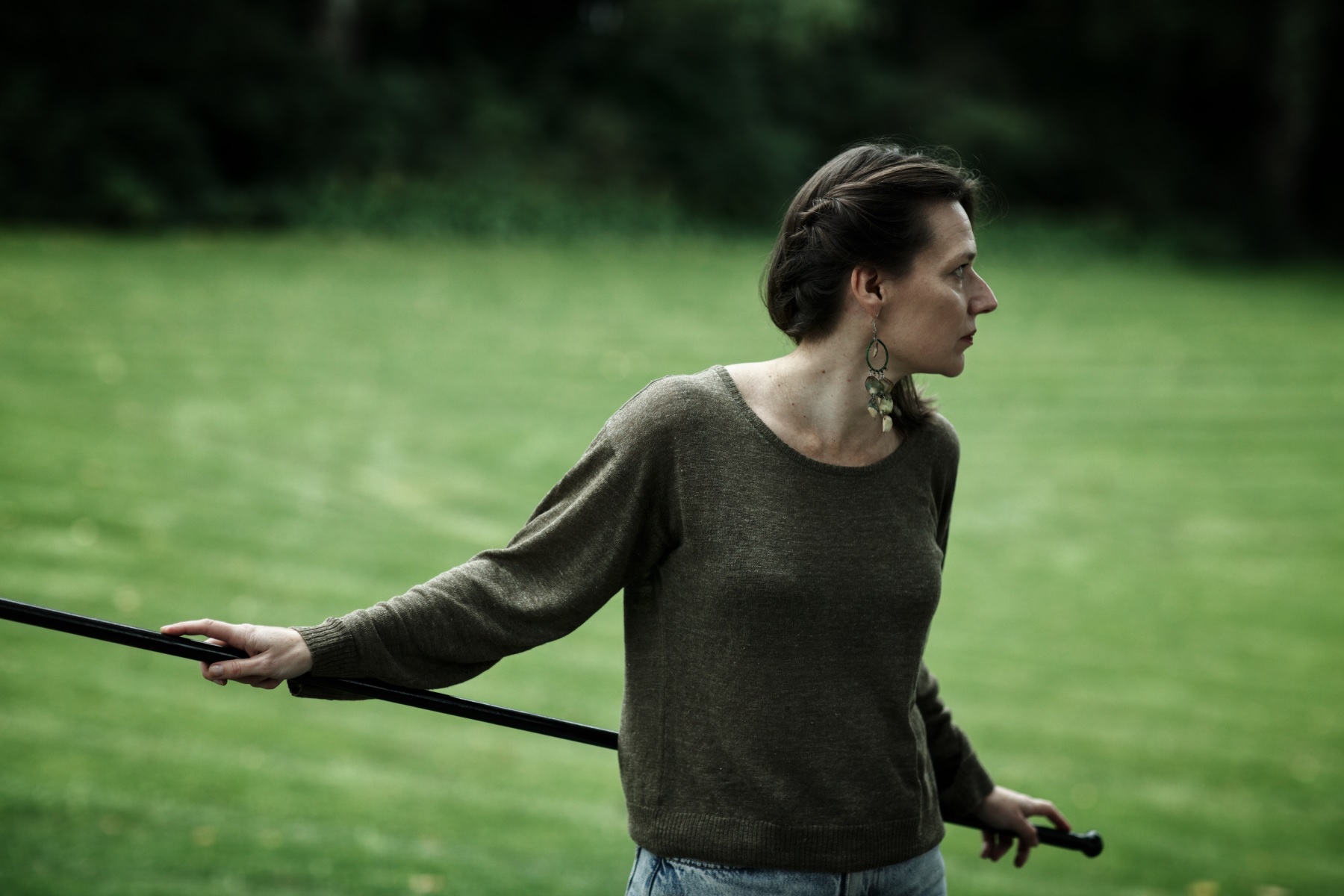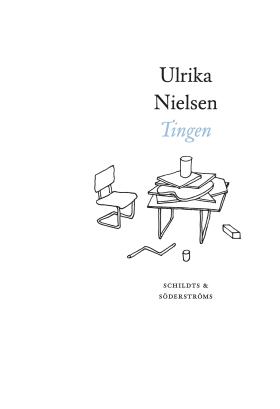from The Things. A Poem-Essay
by Ulrika Nielsen
translated and introduced by Darcy Hurford
Since making her debut in 2001, Ulrika Nielsen has published some nine books, including novels, poetry and prose. Originally from Ostrobothnia in Finland, she now lives in Stockholm. As well as being a writer and critic Nielsen is also a member of the editorial board at Ellips publishing, based in Vaasa. In 2015 she won Svenska YLEs literature prize for the poetry collection Undergången, and she was awarded the Längmanska foundation’s Finland prize in 2019.
Tingen was published in 2022 and nominated for the Runeberg Prize. It’s a poem-essay of 103 pages about things: the objects that surround us, some with sentimental value, some desirable, some an irritant, the meanings we give them and how they shape us. The form is unusual, in that it has something of the structure of an essay in terms of narrative, yet is still poetry, with longer and shorter poems together creating a coherent whole.
There’s an ambivalence towards things; on one hand, we desire and acquire them, on the other, as anyone who’s dealt with a dead relative’s estate (or simply moved house) knows, things come loaded with all kinds of memories and associations. Many texts here take the form of a kind of inventory: lists of objects and their characteristics. People are a gravitational field around which things assemble, Nielsen suggests here, while death, and the sorting of what’s left behind is a kind of ‘Big Bang’ of objects. While Tingen’s starting point is autobiographical, the topic is universal.

from The Things
I visited a friend.
Like a young person leaving home
she’d got a flat of her own
on the same street as the flat she shares
with husband, kids and a green budgie.
A hallway, a kitchen, a room.
There she had almost nothing.
I remember the flat being light,
with air with
air flowing through it.
The strains of a cello from a small loudspeaker
intensified the feeling of air, of space and light,
drew lines, creases, pathways through the space,
opened the space.
[…]
This is something I cannot explain in words, like this:
I went out into the street.
A warm late-summer breeze
came towards me, I felt like somebody else,
or nobody; in other words I felt like myself
adrift, as if detached yet also
shaken and envious
of all this nothingness
my friend was bearing.
A furious desire for an empty echoing room,
a mattress, a wooden floor, a large window,
a hazy sea, some fishing boats.
A sink in the kitchen, a tap, one single glass,
a dryness, a roughness to the floors, the air.
I see myself standing at the sink,
just simply drinking a glass of water from a glass.
I walked homewards
with a growing dread
and noticing
all these things blowing around.
Stopped at a shop window that had designed
objects made of glass.
What should you do with what you’ve become?
[…]
(So that the things will begin speaking to me again.)
I
LOVE POEM
We have plenty of matches in our house.
We keep them on hand always.
Currently our favorite brand is Ohio Blue Tip,
Though we used to prefer Diamond Brand.
RON PADGETT
You’re a gravitational field.
The things assemble around you
and within you work is under way
so that you don’t sink even deeper
downwards, inwards, towards the anonymous core.
It requires an enormous concentration.
Some of the things are hard to understand,
you don’t know how they ended up here,
where they come from, how it all started,
you don’t remember.
In one of the boxes in the kitchen for example,
the one you sometimes open absent-mindedly
to quickly get rid of something that’s ‘getting in the way’
and where it then remains, neglected.
It might be things that could come in useful,
like elastic bands, paperclips, pens, wires, tubes of glue,
rulers, painkillers, magnets, cleaning spray
for glasses, matches, music boxes, cotton reels, tape,
tape measures, incense sticks, magnifying glasses, playing cards,
hole punches, torches, lighters, but also deceased
things like old batteries, broken lightbulbs,
dried-up biros, fragile balloons and
fading streamers that missed the party, Christmas cards of
the impersonal sort, candle stumps, scratched sunglasses
with missing temples, broken jewellery, plastic sachets
with spare buttons for clothes you don’t have any more,
expired passports and ID cards or membership cards for
sports facilities or chains of stores that have ceased
to exist, faded receipts, cables for old
bank card readers, two dented pieces of chewing gum in a
worn-out shiny wrapper…
Sometimes you don’t even know what it is.
What is this? Some kind of tool made of metal.
Could you use it to poke something out
maybe, from a cranny or from the floor drain,
is it linked to an extinct technology, cookery?
What out of all this do you really like?
I asked myself once I was back home
and calmed from my fury
which we can call falling sick among things.
Maybe I ought to linger on that fury,
it took the form of an incoherent outburst.
It began in the hallway
where I stomped around in the street grit
among carrier bags and other bags
and overwhelming quantities of shoes,
umbrellas, newspapers and letters
and it ended in a summary:
We need to empty the entire flat,
take everything out into the yard
and take back in only the things
we still need and still like.
I sounded like an interior design trend,
like climate anxiety, live more simply,
but what I was feeling
was something else
it was hard for me
to make myself understood,
this is serious: I can’t breathe,
can’t take another step
In any direction whatsoever.
What has all this stuff
got to do with me?
What does it want?
A lot of my time
I devote to
handling, picking up, carrying,
moving, scooping
and carting things
from one room to another
from the inhabitable surfaces
to the storage areas and wardrobes
and down to the basement
and up again
and as I scoop and cart
and think that for once and all I’m ‘getting rid of it’
it’s as if new objects
squeeze themselves forward
from existence itself,
gush in through the letterbox,
rise up from the floorboards and tabletops
as the crumbs and the dust whirl
and through all of it hovers a question:
where is the line between active things
and dead things; where is the line
between inactive things and rubbish?
But Mum, you can’t chuck out
this sofa, I’ve grown up on it,
these are my things too
and my toys
and you love
your thousand-five-hundred books
just like you love us.
I like the olive-green ceramic dish
with furrows like the age rings on a tree.
I like a small sculpture called ‘The Thinker’
that’s a comment on the original sculpture.
I like the cacti and the succulents,
the fern I inherited from Auntie S.
I like the sushi dishes, the water jug of grey glass,
the Finnish cutlery and the Japanese carving knife.
I like the brown-glazed pot, the peace lily
and the rustly atmosphere around the weeping fig.
I like the desk lamp with the turquoise velvet shade.
I like some sheets with graphic patterns
from Finlayson that we picked up
at Prisma in Jakobstad in the summer of 2020
when like every summer when we go back home
we wanted to return with something from Finland
and the little crystal chandelier and folding chair in the hallway.
I like the bookshelves and film shelves,
what we take refuge in and seek there in the dark.
I love my kids, my husband, my cat, my mum.
The cat’s expression, how the cat looks at us
And at the things surrounding us.
The dignity of the chairs
The laziness of the sofa
The humour of the cactuses
The self-assuredness of the glass cabinet
The secret life of the couch
The Wiener nougat dream of the crystal chandelier
The erotic mystery of the Chinese box
In the house opposite the old lady stands
with henna-dyed brittle hair
on the balcony dusting her things:
bedspread, towels, quilts, rags,
rugs of different sizes.
She has a lot of rugs.
The things set her in motion,
keep her occupied through the days.
She battles against what befalls the things;
dust mites, moths, food, dirt from the street,
her own deposits and exhalations
that stick in the things, are absorbed by them
and give every home its distinct smell.
She dusts, washes, launders, cleans,
rubs, wipes, polishes and airs,
but the smell of her own self
doesn’t let go of the things.
When a person dies
the things lose their gravitational point.
They find themselves adrift.
To start with they stand motionless
in a cooling state,
slowly stiffening in their poses in the cottage:
the china cat, the tea towels,
the teapot, family photographs in gilded frames
and the furniture seems exposed.
They let themselves go in an absence
that creates dejection in those left behind.
Some of them, like an ashtray,
a fern, a picture, some deep dishes,
are shared out and bond,
more or less reluctantly
with other worlds
where they form new compositions.
They are then called heirlooms
and if things go well
they have a particular gleam,
you slip on a pearl necklace
with a particular delight,
say: mind grandma’s vase.
Some objects take on their real meaning
only now.
Detached from a haze
of similar things
and inserted into new contexts
they might resemble a person
detaching and lifting away from childhood.
In spite of everything, we’ll reject
a lot of this.
In the enormous waste containers
at the recycling centre,
mass graves of objects,
things lose their characters,
their functions and their names.
They return to material
as metal, wood, plastic, textiles, glass.
When a container is filled
a front loader arrives
and with its heavy arm
presses the things together
with a violent force.
Now there’s no telling apart one thing from another
or the relief from the guilt.
A flickering feeling without name
we can call it soon everything will forget you.
The sound is deafening; it screeches, thuds, echoes.
squeals, crunches and cracks when the things
cease to be something.
We don’t get close to hazardous waste.
Spray cans, paint and solvents,
but also perfumes.
Advanced chemical processes are required
to separate the bonds.
You construct a world
of things.
Your rooms, your world.
You build your world
of things.
But the things also build you.

Tingen. En diktessä
Schildts & Söderströms, 2022, 103 pages.
Foreign rights: the author.
We are grateful to Schildts & Söderströms and Ulrika Nielsen for permission to publish this translated extract.
Since making her debut in 2001, Ulrika Nielsen has published some nine books, including novels, poetry and prose. As well as being a writer and critic Nielsen is also a member of the editorial board at Ellips publishing, based in Vaasa. In 2015 she won Svenska YLEs literature prize for the poetry collection Undergången, and she was awarded the Längmanska foundation’s Finland prize in 2019.
D.E. Hurford is a translator from Estonian, Finnish and Swedish. She lives in Belgium.
